Modern devices designed for cleaning premises cannot completely replace the good old traditional broom. This ancient household product is still in demand in every home today. Of course, the current brooms are technologically significantly different from their predecessors, but they are also good at home cleaning. To find out what brooms are made of for sweeping the floor and how to make a product with your own hands, a short review from the editorial staff of HouseChief will help.
Read in the article
- 1 What are brooms for sweeping the floor made of: options
- 1.1 Brooms and brooms from natural raw materials
- 1.2 Artificial cleaning assistants
- 2 Popular models of household brooms and brushes
- 2.1 Brooms from sorghum and other natural raw materials
- 2.2 Plastic, rubber and other synthetic models
- 2.3 Electric brooms are no joke
- 3 Choosing the perfect floor sweeping tool
- 3.1 Universal broom - what is it?
- 3.2 Special samples
- 4 How to make a broom with your own hands
- 4.1 How to grow crown sorghum in your backyard
- 4.2 How to knit brooms at home
- 5 Home broom care
- 5.1 How to prepare a broom for use
- 5.2 Proper storage of the broom
What are brooms for sweeping the floor made of: options
The centuries-old history did not make significant changes in the appearance of the ancient device - the materials and production methods were slightly modified.

Today, both natural and artificial raw materials are used for household appliances.
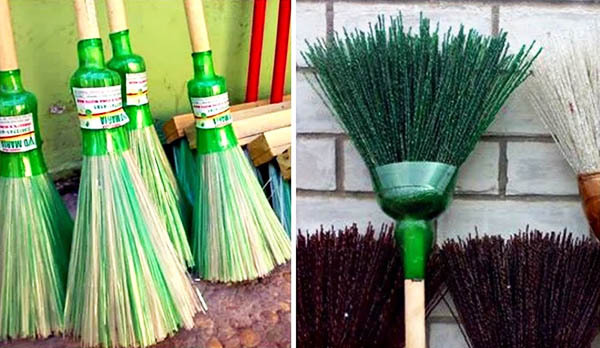
The main manufacturing method is the separation of light and flexible material into thin fibers, followed by fastening to the handle. Such a tool will cleanly sweep small household waste from any corner.
Brooms and brooms from natural raw materials
Most often, natural materials are used to make a home broom, it is also called a broom or broom.
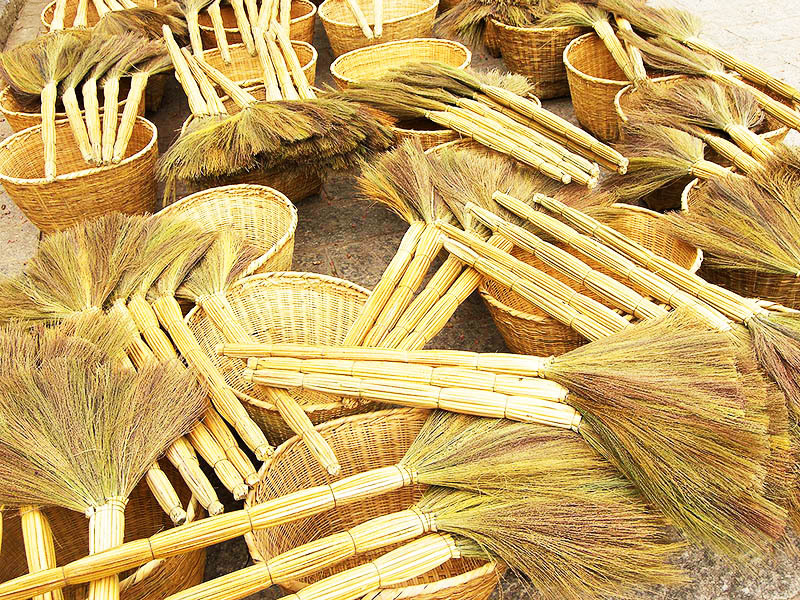
Our ancestors knitted panicles from grass stems and shrub branches using:
- common wolfberry;
- oregano;
- sagebrush;
- St. John's wort;
- reed;
- millet.
Such a broom created a pleasant aroma and drove out harmful insects. Today these grasses have replaced the soft panicles of the grassy sorghum shrub found everywhere.
Artificial cleaning assistants
A wide range of synthetic brushes and brooms is designed for cleaning all floors and outdoor areas. The quality of cleaning is not worse, and the more plastic fiber will not harm the expensive surface. For the manufacture of brushes, various polymers are used, less often rubber.
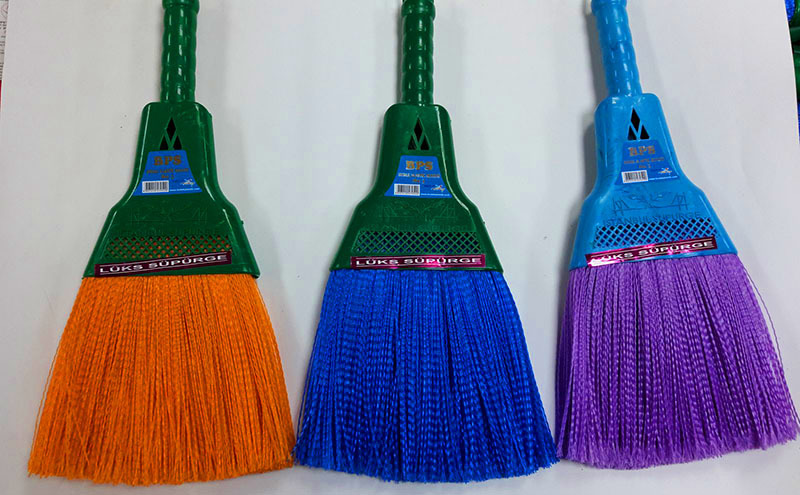
The price of the product depends on the quality characteristics of the raw materials and the brand awareness of the manufacturer. The main advantage over the natural analogue is the long service life and the possibility of disinfection treatment.
Popular models of household brooms and brushes
Modern broom brushes are versatile - they are able to remove fine dust from carpet and rather large debris.
Brooms from sorghum and other natural raw materials
The ecological purity of natural raw materials has always been appreciated, and often housewives prefer natural brooms, in particular from crown sorghum. An annual unpretentious shrub native to Africa, slightly similar to corn, today it grows in the southern regions almost everywhere. A plant with a strong stem and panicle branches, when fully ripe and the formation of reddish-brown seeds, makes it possible to obtain very high-quality products.
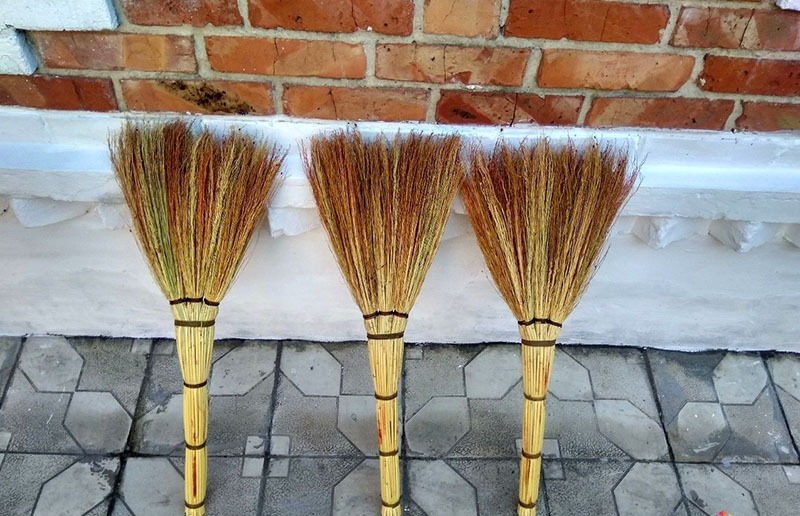
It is not difficult to make them yourself, saving a little on the family budget. The disadvantages include the quick brittleness of the twigs.
Plastic, rubber and other synthetic models
Retail chains provide the widest selection of synthetic products for cleaning rooms with any coatings.
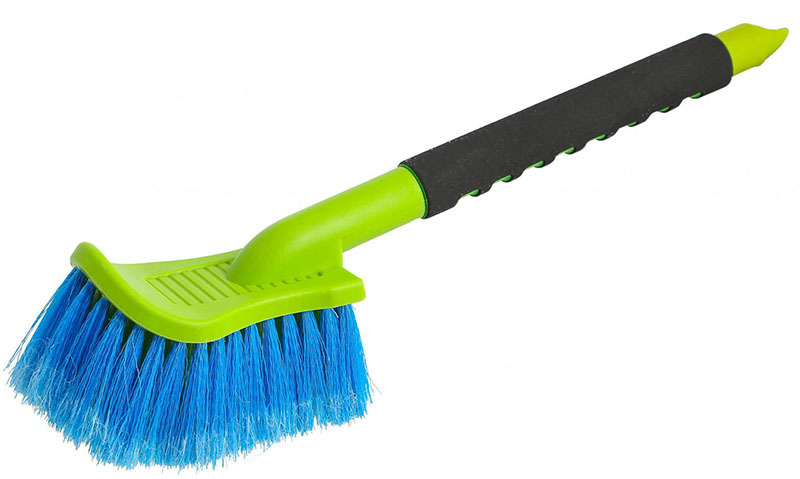
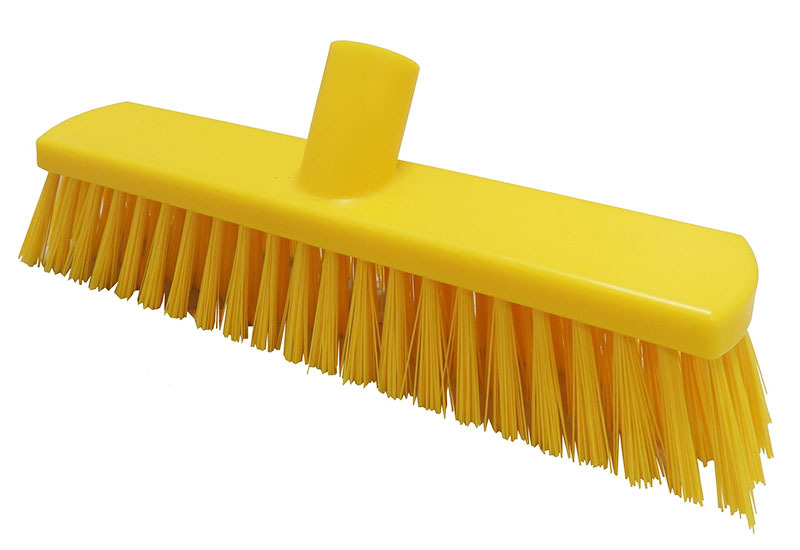
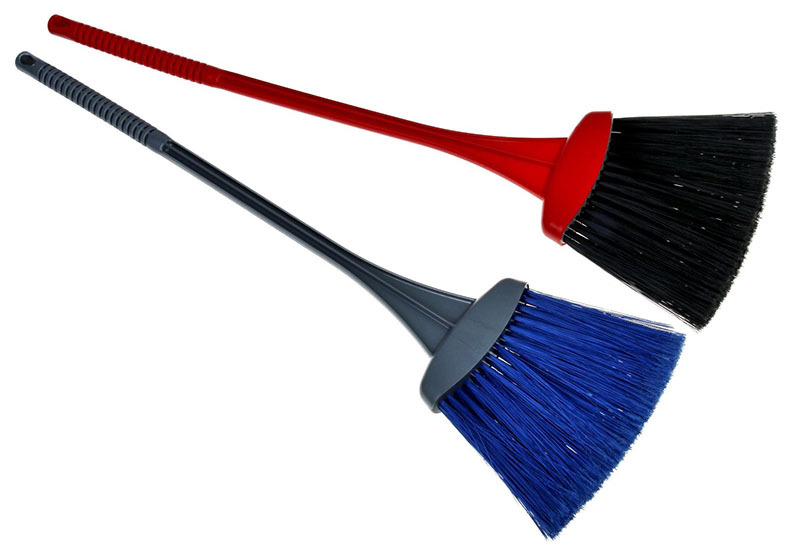

Electric brooms are no joke
Modern and convenient devices are in demand among busy people who value their time. The device comes with various attachments and a telescopic handle.
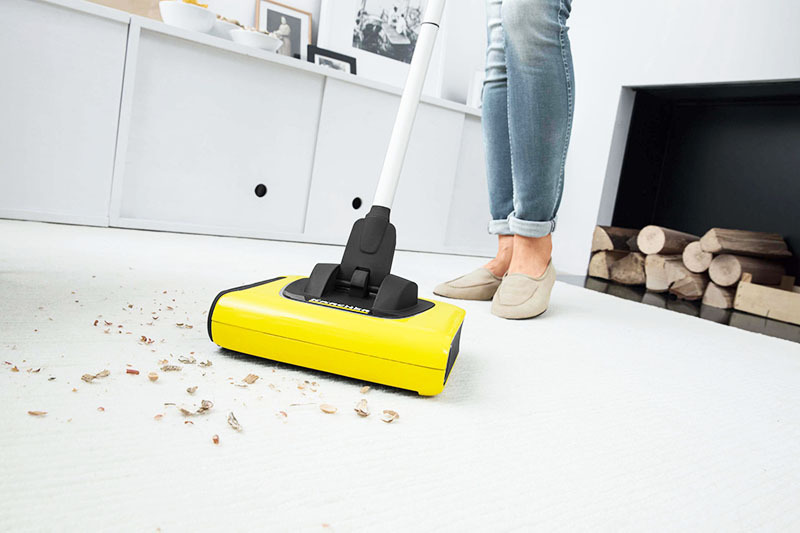
Dusty debris is concentrated in a small container that is simply emptied after shutdown.
Choosing the perfect floor sweeping tool
The variety of lineup in retail chains can make it difficult to choose the right product. Before purchasing it is a good idea to decide which household appliance will be more comfortable for you - natural from natural raw materials or artificial from synthetic materials.
Universal broom - what is it?
A conventional universal brush is rectangular and equipped with a long plastic handle.

The pile material of the bristles is rather coarse, 8-10 cm long. The width of the working surface is on average 25-30 cm.
Special samples
Other broom brushes are more specialized and are selected separately for cleaning laminate, carpets, wet cleaning.
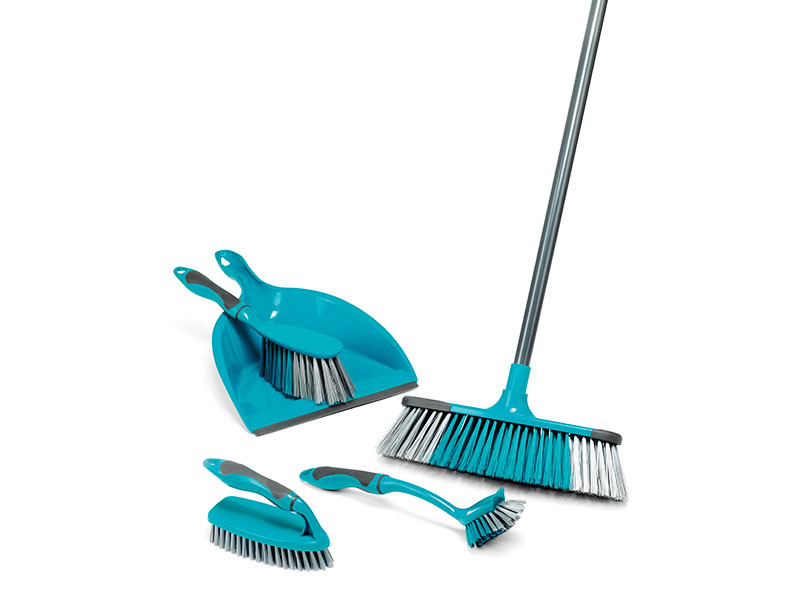
It is impossible to determine with certainty which product is the best. To tell you the truth, there should be several models in the house.
How to make a broom with your own hands
It is not so difficult to make a natural broom for your household yourself. First you need to buy seeds and, observing the technological processes of cultivation, grow sorghum in your garden.
How to grow crown sorghum in your backyard
For a drought-resistant plant, the temperature regime is very important. Wet and cold weather is not conducive to full maturation. The following stages of agrotechnical techniques can be distinguished:
- Sowing of seeds is carried out at stable temperatures + 15... + 16 0WITH.
- For sowing, 12-15% more seed is taken - weak growth is removed.
- Sow on beds with row spacing 35-40 cm, depth 3-4 cm with a distance of 2-3 cm.
- After the emergence of shoots, the first weeding is done, the second - with a shoot height of 6-7 cm. In the same period, plantings are thinned out and weak shoots are removed, leaving a distance of 6-8 cm.
- When the seedlings reach a height of 15-20 cm, the third weeding is carried out with the removal of underdeveloped shoots.
- Ripening of the shrub is determined by slight reddening of the panicles and the absence of milk in the grains when crushed. Meter stems are suitable for cutting.

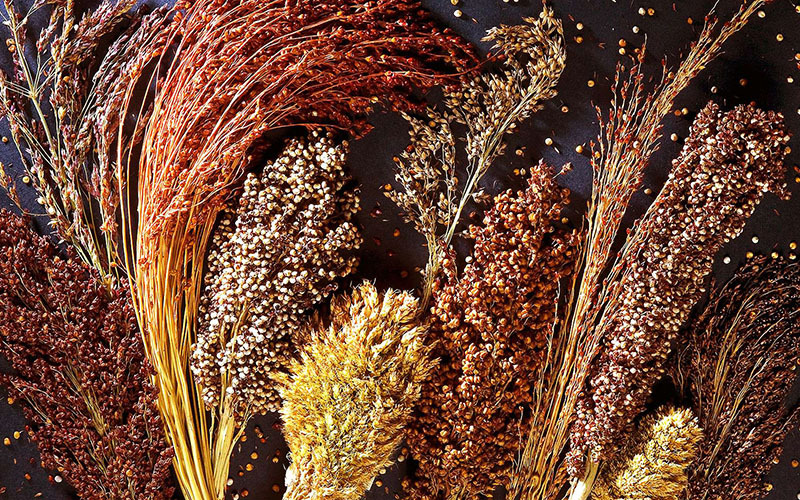
The plants are then suspended and dried for 2 weeks in a well-ventilated area.
A simple bucket is used to remove grains from sorghum. The stems are pressed against the edge with a bucket handle and pulled towards themselves. There is also a special comb for these purposes.
How to knit brooms at home
After drying and cleaning the sorghum, you can start forming the broom itself. Using step-by-step instructions with a photo, it will not be so difficult to knit a simple and reliable household cleaning tool.
| Illustration | Stage description |
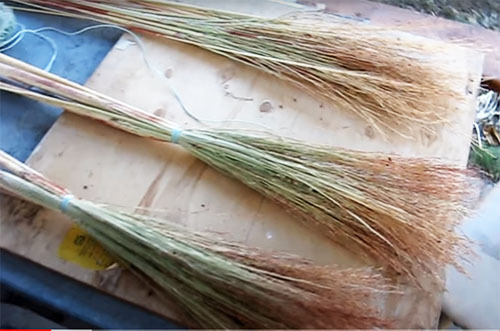 | Dried plant stems are laid out on a flat surface, distributing them into 3 sheaves. In this case, more powerful stems are placed outside, and small panicles - inside. |
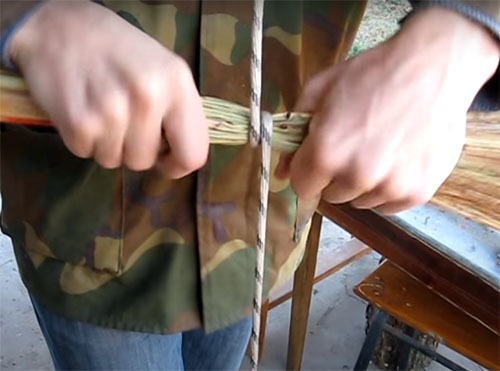 | A rope (2 m) fixed at the top (from below it is weighted with a wooden stick), the sheaf is tied with a loop and tightly tightened by pressing the foot on the stick. |
 | A nylon or any synthetic thread is pulled in the middle of the bundle and wrapped around it next to the rope. |
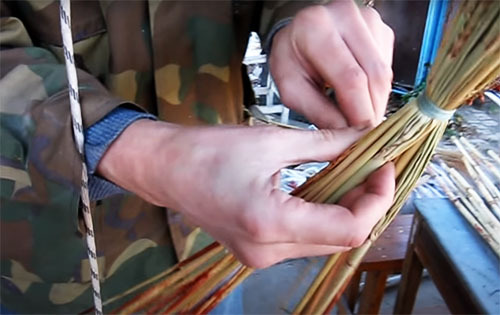 | After tying the knots, the ends of the thread are pulled up and passed again through the bundle. |
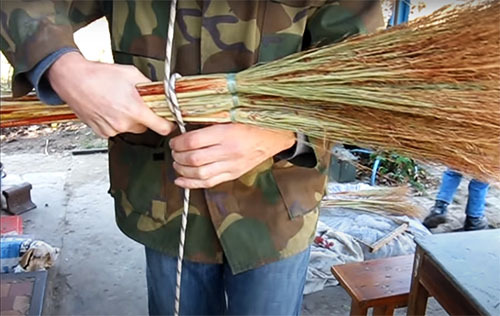 | Similarly, tie the remaining sheaves and pull together above the first bundle |
 | With a nylon thread, they tie up the place of the tie and hide the ends inward. |
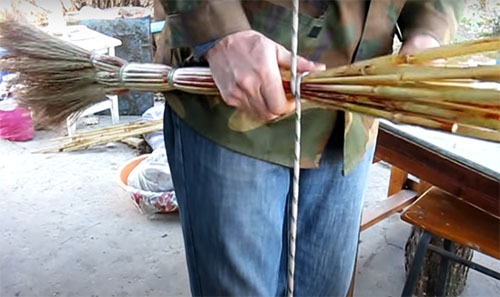 | The future handle is pulled together with a rope 2 more times every 10-12 cm and fixed with a thread. |
 | Excess stems are cut and trimmed at a slight angle. |
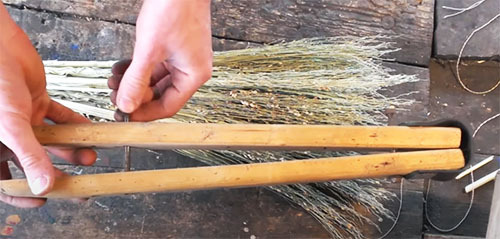 | For flashing the product, a device of 2 strips with holes on the rubber connection is used. The crown panicle is carefully straightened, inserted between the rails and tightened with bolts. |
 | The product is sewn like a shoe - with an awl and 2 threads. The lower thread is picked up with an awl and dragged upward, where the upper thread is pulled into the resulting loop. |
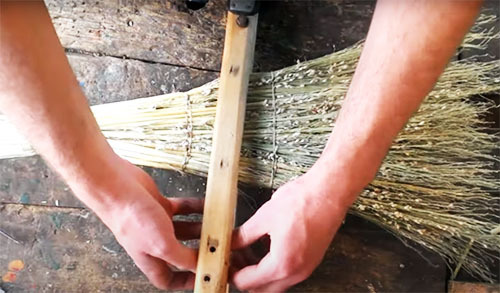 | The broom is similarly stitched below the fastening strips. |
It is probably much easier to purchase a finished product, but a self-grown, knitted and interestingly designed broom will become an original present for a zealous hostess.

Home broom care
Proper care of your household tool will prevent premature deterioration and significantly prolong its life. Any new broom can be immediately used for its intended purpose, but not everyone knows that it is better to carry out the preparatory work.
How to prepare a broom for use
Nobody wrote the exact instructions for the correct processing of brooms. But, according to the advice of experienced grandmothers, the whole point is that a new product should be scalded. Better yet, pour boiling saline at the rate of 3-5 tbsp. spoons in a 10-liter bucket. To soften the rods and extend the service life, it is advisable to leave the broom in the solution for a couple of hours. After steaming, the product is thoroughly dried, ideally in a crushed position.
How to extend the life of a broom - in this short video:
Proper storage of the broom
A good broom even looks sturdy and neat. Proper storage will help maintain the presentable appearance of the product. Brooms are best kept hanging or horizontal.
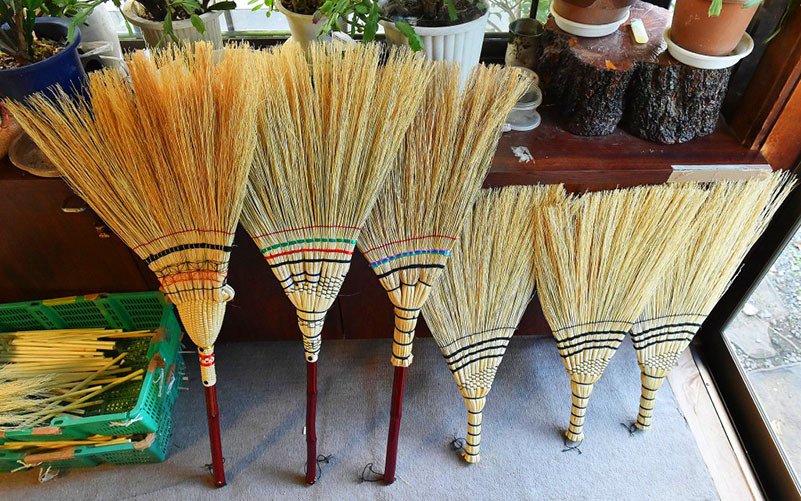
It is strongly not recommended to leave the throwing part on the floor, as well as near any heating devices - the broom will quickly become dry and brittle.
Of course, against the background of modern appliances, a broom is an archaic product, but the need for it is indisputable. Accidentally spilled crumbs, a small rubbish patch on the floor are much faster and more convenient to clean with a compact broom than to climb into the closet for a large vacuum cleaner.



